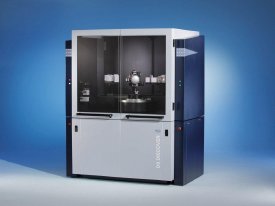At Analytica 2010, Bruker AXS, the market leader in X-Ray Diffraction (XRD), introduces its next-generation D8 DISCOVER diffraction system for advanced materials research.

The new D8 DISCOVER is the successor to the most popular X-ray diffractometer on the market. While maintaining the strengths of its predecessor, the new D8 DISCOVER further increases ease-of-use with real-time component detection, plug-and-play functionality and fully integrated 2-dimensional XRD2 capabilities. These unique features allow the user to easily switch between all materials research X-ray diffraction applications, including reflectometry, high-resolution diffraction, grazing incidence diffraction (IP-GID) and small angle X-ray scattering (SAXS), as well as residual stress and texture investigations. In particular, for micro-diffraction and ultra-fast reciprocal space mapping, the new two-dimensional VǺNTEC-500 detector with 2048x2048 channels at 14.4 cm2 active area provides highest sensitivity for detecting even the weakest diffraction signals in short measurement times. The new D8 DISCOVER is designed to meet all the latest X-ray safety regulatory requirements, providing scientists peace-of-mind.
An integral part of the new D8 DISCOVER is the new DIFFRAC.SUITE software with consistently implemented automation functionality. An X-ray optics module, a detector, or any accessory mounted onto the instrument registers itself in real-time with its relevant parameters and analytical capabilities, including powerful detection of possible component conflicts. The factory-aligned, snap-lock X-ray optics provide true 'plug-and-play' functionality, including automatic and tool-free switching of the diffraction geometry with minimal user intervention. The DIFFRAC.SUITE offers intuitive operation based on a graphical user interface that can be customized to match the operator's requirements.
"The new D8 DISCOVER incorporates XRD2 capabilities, featuring the brand new two-dimensional VǺNTEC-500 detector based on Bruker's proprietary MikroGap technology. Its outstanding capabilities, including the large active area of 14,400 mm2, enable materials research with outstanding spatial resolution and short measurement times. This will allow our users a new view into the nano-materials world," stated Dr. Geert Vanhoyland, XRD Product Manager at Bruker AXS.
"Applying a 'Leonardo DaVinci' design philosophy to a modern system enables expert analytical XRD capabilities while minimizing user interventions. Incorporating numerous proprietary innovations, the new D8 DISCOVER offers unrivaled ergonomics, turning a complex research instrument into an easy to use routine tool for everyone," commented Dr. Lutz Brügemann, Director of R&D and Marketing at Bruker AXS.